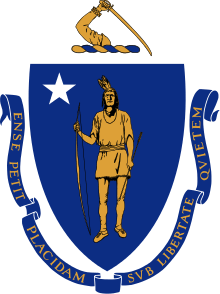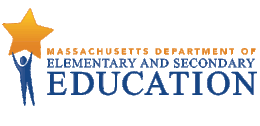Massachusetts Department of Elementary and Secondary Education
The Massachusetts Department of Elementary and Secondary Education (DESE), sometimes referred to as the Massachusetts Department of Education, is the state education agency for the Commonwealth of Massachusetts, identified by the U.S. Department of Education.[3] It is responsible for public education at the elementary and secondary levels. The agency has its headquarters in Malden.[4] It is governed by the Massachusetts Board of Education.
 | |
 | |
| Department overview | |
|---|---|
| Formed | 1789 [1] |
| Jurisdiction | Commonwealth of Massachusetts |
| Headquarters | 75 Pleasant St Malden, MA 02148 |
| Department executive |
|
| Website | http://www.doe.mass.edu/ |
See also
- Massachusetts Board of Education
- Massachusetts Tests for Educator Licensure
- List of high schools in Massachusetts
- Early Childhood Resource Centers in Massachusetts
Early Childhood Resource Centers in Massachusetts
The program started in 1991 by the Early Education Department, who still runs and funds this grant today. The purpose of these centers is to facilitate the availability and accessibility of early childhood materials and resources statewide. Partnering with libraries has enabled broader access for parents, schools, child care agencies, and other entities involved with early education care and intervention.
These Resource Centers provide education materials that range from professional resource books, parenting books, videos & DVDs, teaching curriculum kits, themed picture books, big books, and many other items that are available for borrowing at no charge. Throughout the school year there are also teacher trainings available where professionals can earn early education credits or professional development hours. These trainings vary by location, so please contact the specific location with inquiries.
As of 2017 there are five Early Childhood Resource Centers (ECRC) in Massachusetts.
- Cambridge Public Library
http://www.cambridgepubliclibrary.org
- Falmouth Public Library
http://www.falmouthpubliclibrary.org/?/kids/early-childhood-resource-center/
- Haverhill Public Library
- Norfolk Public Library
http://library.virtualnorfolk.org/Public_Documents/NPL_ecrc/ecrc
- Springfield Public Library
Further reading
Chalufour, I., & Worth, K. (2003). Discovering nature with young children (The Young Scientist Series). St. Paul, MN: Redleaf press.
Chappell, B. J. (2008). Children helping children with grief: my path to founding the Dougy Center for Grieving Children and Their Families. Troutdale, OR: Newsage Press.
Charner, K., Murphy, M., & Clark, C. (2012). The giant encyclopedia of lesson plans for children 3 to 6: more than 250 lesson plans created by teachers for teachers. Lewisville, NC: Gryphon House.
Ernst, L. L. (2015). The essential lapsit guide: a multimedia how-to-do-it manual and programming guide for stimulating literacy development from 12 to 24 months. Chicago, IL: Neal-Schuman, an imprint of the American Library Association.
Fein, D. (2016). The activity kit for babies and toddlers at risk: how to use everyday routines to build social and communication skills. New York, NY: The Guilford Press.
Fields, M. V., & Fields, D. (2006). Constructive guidance and discipline: preschool and primary education (4th ed.). Upper Saddle River, NJ: Pearson/Merrill/Prentice Hall.
Gartrell, D. (2004). The power of guidance: teaching social-emotional skills in early childhood classrooms. Clifton Park, NY: Thomson/Delmar Learning.
Gestwicki, C. (2017). Developmentally appropriate practice: curriculum and development in early education (6th ed.). Australia: Cengage Learning.
Heinecke, L. L. (2016). Outdoor Science Lab for Kids. Beverly, MA: Quarry Books.
Kumin, L. (2001). Classroom language skills for children with Down syndrome: a guide for parents and teachers. Bethesda, MD: Woodbine House.
Lambert, M. D. (2015). Reading picture books with children: how to shake up storytime and get kids talking about what they see. Watertown, MA: Charlesbridge.
Landy, S. (2002). Pathways to competence: encouraging healthy social and emotional development in young children. Baltimore, MD: Paul H. Brookes.
Lieberman, V. H. (2003). Play at the center of curriculum. Upper Saddle River, NJ: Merrill/Prentice Hall.
Lieberman, V. H. (2003). Play at the center of curriculum (3rd ed.). Upper Saddle River, NJ: Merrill/Prentice Hall.
MacMillan, K., & Kirker, C. (2012). Kindergarten magic: theme-based lessons for building literacy and library skills. Chicago, IL: American Library Association.
MacMillan, K. (2014). Baby storytime magic: active early literacy through bounces, rhymes, tickles, and more. Chicago, IL: ALA Editions, American Library Association.
Manasco, H. (2012). An exceptional children's guide to touch: teaching social and physical boundaries to kids. Philadelphia, PA: Jessica Kingsley.
Moore, L. O. (2009). Inclusion Strategies for Young Children (2nd ed.). Thousand Oaks, CA: Corwin Press.
Nevills, P., & Wolfe, P. (2009). Building the reading brain, preK-3 (2nd ed.). Thousand Oaks, CA: Corwin Press.
Oelwein, P. L. (2009). Teaching reading to children with Down syndrome: a guide for parents and teachers. Bethesda, MD: Woodbine House.
Ohanesian, D. C. (2006). The big book of pre-K learning centers: activities, ideas & strategies that meet the standards, build early concepts, and prepare children for kindergarten. New York: Scholastic Teaching Resources.
Ohanesian, D. C. (2006). The big book of pre-K learning centers: activities, ideas & strategies that meet the standards, build early concepts, and prepare children for kindergarten. New York: Scholastic Teaching Resources.
Petersen, E. A. (1996). A practical guide to early childhood planning, methods, and materials: the what, why, and how of lesson plans. Boston, MA: Allyn and Bacon.
Phelan, T. W., & Schonour, S. J. (2016). 1-2-3 magic in the classroom: effective discipline for pre-K through grade 8. Naperville, IL: Sourcebooks, Inc.
Pianta, R. C., & Kraft-Sayre, M. (2003). The kindergarten transition guide: connecting children, families, and schools. Baltimore, MD: P.H. Brookes.
Puerling, B. (2012). Teaching in the digital age: smart tools for age 3 to grade 3. St. Paul, MN: Redleaf Press.
Sandall, S. R., & Schwartz, I. S. (2008). Building blocks for teaching preschoolers with special needs. Baltimore, MD: Paul H. Brookes Pub. Co.
Sandall, S. R., & Schwartz, I. S. (2008). Building blocks for teaching preschoolers with special needs (2nd ed.). Baltimore: Paul H. Brookes Pub. Co.
Schiller, P. B., Bartkowiak, R., & Wright, D. (2003). The complete resource book toddlers and twos: over 2000 experiences and ideas! Beltsville, MD: Gryphon House.
Selly, P. B. (2012). Early childhood activities for a greener earth. St. Paul, MN: Redleaf Press.
Thompson, T. (2007). Making sense of autism. Baltimore, MD: Paul H. Brookes Publishing.
Thompson, T. (2008). Dr. Thompson's straight talk on autism. Baltimore, MD: Paul H. Brookes Pub. Co.
Thompson, T. (2008). Dr. Thompson's straight talk on autism. Baltimore, MD: Paul H. Brookes Pub. Co.
Thompson, T. (2008). Dr. Thompson's straight talk on autism. Baltimore: WaterBrook Press.
Tubbs, J. (2008). Creative therapy for children with autism, ADD, and Asperger's:. Garden City Park, NY: Square One.
Willis, C., Talley, M., Doyle, M. F., & Johnson, D. (2015). Teaching young children with autism spectrum disorder updated with new DSM-5 information. Lewisville, NC: Gryphon House.
Notes and references
- "The Development of Education in Massachusetts". vc.bridgew.edu. The Commonwealth of Massachusetts Department of Education. 1930. Retrieved 26 September 2019.
- "Office of the Commissioner". Retrieved 26 September 2019.
- State Education Agencies
- "Contact DESE." Massachusetts Department of Elementary and Secondary Education. Retrieved on February 29, 2012. "75 Pleasant Street Malden, MA 02148-4906"